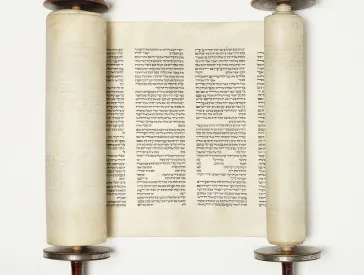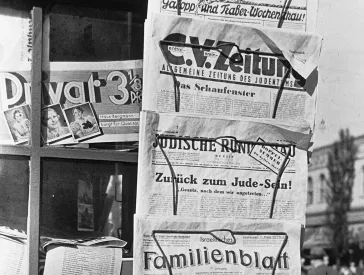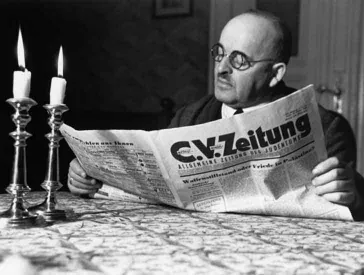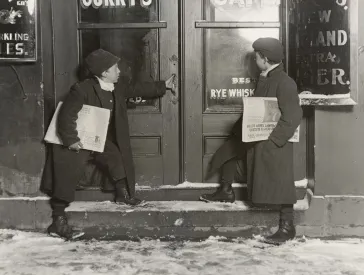"How German is it? 30 Artists’ Notion of Home"
Press Invitation to the Opening of the Special Exhibition Marking the 10th Anniversary
Press Release, Thu 25 Aug 2011
Is there such a thing as a collective national identity? How do they see themselves, the citizens of the Federal Republic of Germany and the people from other countries who live in Berlin, Munich, or Frankfurt – whether they grew up in West or East Germany, whatever religion they practice, whether their origins are Russian, Turkish, or something else? The coordinates of a familiar self-image started to shift when the Soviet Union and the German Democratic Republic collapsed, long before Germany reluctantly began to define itself as a country of immigration. The Jewish Museum Berlin is seizing the opportunity of its 10th anniversary to explore how it feels to be German: The special exhibition "How German is it?" (16 September 2011 to 29 January 2012) shows works by 30 artists who take perceptions in and of Germany as their artistic themes. Eight works were commissioned exclusively for the exhibition and created by the following artists: Arnold Dreyblatt, Via Lewandowsky and Durs Grünbein, Anny and Sibel Öztürk, Julian Rosefeldt, Misha Shenbrot, Paul Brody, Azra Akšamija, and Lilli Engel and Raffael Rheinsberg.
We cordially invite you to attend the press conference and the exhibition opening on Thursday 15 September 2011.
- Contact
-
Press office
T +49 (0)30 259 93 419
presse@jmberlin.de
- Address
Jewish Museum Berlin Foundation
Lindenstraße 9–14
10969 Berlin
Press Conference
| With | Cilly Kugelmann, program director, Jewish Museum Berlin Margret Kampmeyer, exhibition curator, Jewish Museum Berlin |
|---|---|
| Artists attending the Press Conference | Emily Hass, Via Lewandowsky, Julian Rosefeldt, Misha Shenbrot, Miguel Rothschild, Maria Thereza Alves and Ronen Eidelman. |
| When | 15 September 2011, 11 am |
| Exhibition Preview | from 10 am |
| Where | Old Building, first level, Education Room |
Evening Opening Program
-
Words of welcome
-
"Im Wartestand der Gegenwart"
-
On the exhibition
-
One Easy Piece
Cilly Kugelmann, program director, Jewish Museum Berlin
Via Lewandowsky, artist
Margret Kampmeyer, exhibition curator, Jewish Museum Berlin
Paul Brody, performance artist
| When | 15 September 2011, 7 pm |
|---|---|
| Where | Glass Courtyard, ground level |
| Admission | free |
The Exhibition "How German is it? 30 Artists’ Notion of Home"
The Jewish Museum Berlin is seizing the opportunity of its 10th anniversary to take a snapshot in time of the relationship that people living there have to Germany: A Germany that – through the collapse of the Soviet Union, the reunification of the two German states, and the recognition that almost 20 % of its citizens have a so-called migration background – has visibly altered. The distance of time to the Holocaust and the immigration of Jews from the former Soviet Union have also brought about a radical shift in the self-image of Jews in Germany during the last 20 years.
The curators’ aim was to explore how "ethnic" and naturalized citizens, newcomers from abroad, Jews, Muslims, Christians, and the religiously indifferent live in Germany today, how they relate to this state and this society, and how they see themselves as Germans – the age-old themes of "foreignness" and "otherness," of exclusion and belonging, are discussed anew under the premise of current circumstances. Such questions are amongst the Jewish Museum’s core themes.
Through the exhibition "How German is it?", the Jewish Museum Berlin explores phenomena that lie somewhere between national consciousness, a sense of home, belonging, and exclusion. The museum has chosen a subjective approach – the works of contemporary artists – for this exploration.
26 Stances on German Reality
Artists who live or have lived in Germany and for whom today’s Germany is a key theme in their work were selected for the exhibition. Central aspects of their perception are the focus – the works reflect on family and collective memory, national myths, experiences of migration, and lastly language and religion. The installations, video and film works, photographic series, paintings, and prints were all created in the last 10 years.
Experiences of migration and feeling foreign are at the heart of the photo series "Ich werde deutsch" (I become German) by the Iranian-born artist Maziar Moradi. These feature key moments in the biographies of people who have immigrated to Germany or who are rooted in another culture. The sisters Anny and Sibel Öztürk with roots in Turkey and Frankfurt have designed a 16-meter wide wall installation. The Californian performance artist Paul Brody presents sound biographies in his sound installation "Five Easy Pieces," which condenses discussions on living in Germany in several compositions. The exhibit by the Bosnian-born artist Azra Akšamija is called "Dirndlmoschee" – a modern dirndl dress that can be transformed into a prayer room for 3 people, playing on the link between Islamic tradition and the Western world.
Several works are concerned with family and collective memory. The New York musician and artist Arnold Dreyblatt has created in his first autobiographical piece "My Baggage" an installation with 150 documents from his family history from Eastern Europe, the USA, and Berlin. The Israeli artist Maya Zack has reconstructed German "Living Rooms" after the narrative of a Jewish inhabitant who fled in the 1930s and shows them as large 3D pictures.
National myths are explored in several of the works of art. Two pieces pick up on an emotional reference point in Germany – the German forest. Lilli Engel and Raffael Rheinsberg have designed a "Naturkunstzelle" (Natural Art Cell), a large, yew-hedge cube confronting visitors with the German allotment idyll. Julian Rosefeldt addresses German forest myths in a film installation: The plot of "Meine Heimat ist ein düsteres wolkenverhangenes Land" (My home is a Dark and Cloud-Hung Land) deliberately misleads viewers. In its central scene, a grotesque forest performance unfolds with singing Germanic people, demonstrating conservationists, and a wind ensemble.
"What is German?": Popular-culture Archive Room
A documentary exhibition chapter looks back at the last 10 years through popular-culture objects, documents, and films. How has the brand "Germany" changed? From organic supermarkets in model railway scenes through rain ponchos in national colors to potato parties and park guards – the archive room does its own research and explores various aspects of "becoming German."
The Exhibition Design
The exhibition design by "Holzer Kobler Architekturen" (Zurich/Berlin) plays on the architecture of Daniel Libeskind’s design for the new museum building. The designers tilted and rotated the floor plan of the baroque Old Building and implanted it as "White Cube" in the exhibition rooms.
Artists involved: Azra Akšamija, Nevin Aladağ, Maria Thereza Alves, Candice Breitz, Andrea Büttner, Paul Brody, Arnold Dreyblatt, Ronen Eidelman, Lilli Engel & Raffael Rheinsberg, Eldar Farber, Özlem Günyol, Emily Hass, Victor Kégli, Via Lewandowski und Durs Grünbein, Boris Mikhailov, Maziar Moradi, Anny und Sibel Öztürk, Benyamin Reich, Julian Rosefeldt, Miguel Rothschild, Misha Shenbrot, Alexej Tchernyi, Micha Ullman, Clemens von Wedemeyer, Maya Zack.
The exhibition was curated by a team from the Jewish Museum Berlin: Inka Bertz, Denis Grünemeier, Margret Kampmeyer, Cilly Kugelmann, Martina Lüdicke, and Mirjam Wenzel.
With the generous support of the "Stiftung Deutsche Klassenlotterie" and Wall AG.
The exhibition will be accompanied by a comprehensive catalog with illustrations of all the exhibited works, four essays by the curators, texts on the works of art, and a catalog raisonné:
"Heimatkunde. 30 Künstler blicken auf Deutschland" (How German is it? 30 Artists’ Notion of Home) published by the Jewish Museum Berlin. 200 pages, approx. 200 color illustrations, soft cover with fold-in flaps, 24.95 € (museum edition), Hirmer Publishers, Munich.
ISBN: 978-3-7774-5021-6. Press price: 7 euros




